Discover everything about leather cowboy boots – from choosing the perfect pair to expert care tips. Complete guide covering styles, fits, colors, and maintenance for lasting quality.
As a certified footwear specialist with over fifteen years of experience in Western wear and leather goods, I’ve witnessed the enduring appeal of leather cowboy boots transform from ranch necessity to cultural icon.
Whether you’re a first-time buyer overwhelmed by choices or a collector seeking that perfect vintage pair, understanding what makes quality leather boots exceptional will revolutionize your purchase decisions and long-term satisfaction.
Contents
- Why Leather Cowboy Boots Remain the Gold Standard
- Decoding Leather Types for Informed Purchases
- Navigating Popular Cowboy Boot Styles
- Women’s Leather Cowboy Boots: Style Meets Function
- Men’s Leather Cowboy Boots: Classic and Contemporary Options
- Color Selection Strategy for Leather Cowboy Boots
- Vintage Leather Cowboy Boots: Authentication and Value
- Achieving Proper Fit in Cowboy Boots
- Construction Quality Indicators
- Buying Guide: Choosing Your Perfect Leather Cowboy Boots
- Essential Care for Leather Cowboy Boots
- Storage and Longevity Tips
- Matching Leather Cowboy Boots With Outfits
- Seasonal Considerations for Leather Cowboy Boots
- Top Brands for Quality Leather Cowboy Boots
- Common Problems and Solutions
- Sustainability and Ethical Considerations
- Where to Buy Leather Cowboy Boots
- Current Trends in Leather Cowboy Boots
- Key Takeaways for Leather Cowboy Boot Success
- Frequently Asked Questions
Why Leather Cowboy Boots Remain the Gold Standard
The question isn’t whether to choose leather—it’s understanding why nothing else compares. Real leather adapts to your unique foot shape over time, creating a custom fit that synthetic materials simply cannot replicate.
This natural material breathes, regulating temperature while wicking moisture away from your skin during long wear periods.
Full-grain leather, the highest quality tier, retains the hide’s original texture and natural markings. These characteristics aren’t imperfections but signatures of authenticity that tell each animal’s story.
As you wear these boots, the leather develops a rich patina that synthetic alternatives merely attempt to imitate through artificial aging processes.
Top-grain leather offers similar benefits with a more uniform appearance. Manufacturers sand away minor surface imperfections, creating consistency that appeals to those preferring cleaner aesthetics.
Both options deliver exceptional durability when properly maintained, often lasting decades rather than years.
Decoding Leather Types for Informed Purchases
Understanding leather classifications empowers smarter buying decisions. Full-grain leather represents the pinnacle of quality because it includes all natural grain patterns and fiber density.
This unaltered surface develops character through wear, making each pair increasingly unique. Expect these boots to command premium prices, but consider this an investment in footwear that improves with age.
Top-grain leather undergoes minimal processing to remove surface irregularities while maintaining structural integrity. This option balances quality with affordability, making it ideal for buyers seeking durability without maximum investment. The leather still molds to your feet and develops personality, though perhaps less dramatically than full-grain variants.
Exotic leathers introduce distinctive textures and patterns that turn boots into conversation pieces. Ostrich leather features characteristic quill follicles creating bumpy texture and exceptional breathability.
Lizard skin offers small-scale patterns with remarkable flexibility. Snake leather provides bold visual impact with its natural scale patterns. These materials typically require specialized care but reward owners with unmatched uniqueness.
Traditional Western Boots
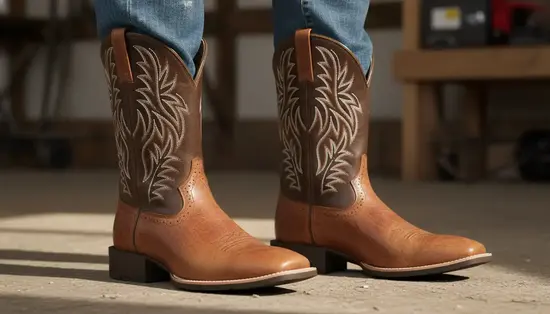
Traditional Western cowboy boots feature the iconic pointed toe and angled heel design that originated from practical riding needs. The pointed toe slips easily into stirrups, while the angled heel prevents your foot from sliding through.
These design elements remain relevant today, even for those who’ve never approached a horse. The classic silhouette pairs beautifully with everything from jeans to flowing dresses.
Roper Leather Cowboy Boots
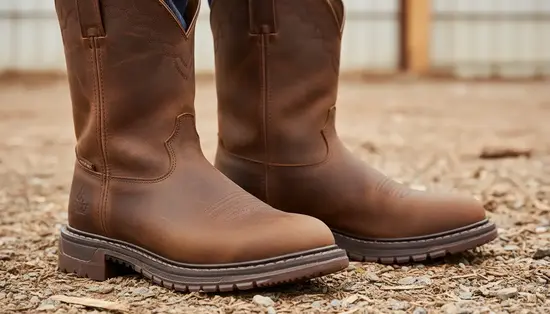
Roper boots present a more understated profile with rounded toes and lower, squared heels. Originally designed for ropers who needed to dismount quickly, these boots offer enhanced walking comfort for modern wearers.
Vintage enthusiasts particularly prize roper styles from heritage brands, as they represent authentic working cowboy culture. The Diamond J line from Justin Boots exemplifies this category’s appeal, combining traditional construction with timeless aesthetics.
Work Leather Cowboy Boots

Work-focused leather cowboy boots incorporate reinforced components addressing job site demands. Steel or composite toe caps protect against falling objects, while oil-resistant soles provide traction on challenging surfaces.
These aren’t your grandfather’s clunky work boots—contemporary designs integrate safety features without sacrificing Western styling.
Fashion and Modern Leather Cowboy Boots
Fashion-forward iterations push traditional boundaries while respecting Western heritage. Designers experiment with shaft heights, embroidery placements, and color combinations that appeal to style-conscious consumers.
These fashion boots particularly showcase innovation, featuring everything from sleek minimalist designs to elaborately decorated showpieces.
Women’s Leather Cowboy Boots: Style Meets Function
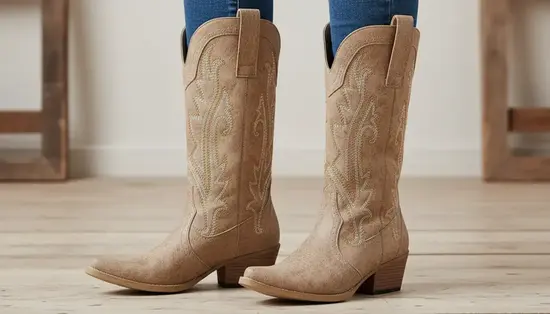
The women’s leather cowboy boot market has experienced remarkable growth recently, with black and brown options leading sales trends. This surge reflects boots’ transition from Western wear specialty to mainstream fashion staple.
Smart buyers recognize that quality women’s boots require the same construction standards as men’s versions—don’t accept inferior materials or shortcuts simply because they’re marketed to women.
Styling versatility makes women’s cowboy boots incredibly practical. Pair black leather cowboy boots with skinny jeans and blazers for polished casual looks. Brown boots complement earth-tone palettes and bohemian styling.
Bold colors like red leather inject personality into neutral outfits. The key lies in balancing boot boldness with outfit restraint, letting your footwear make the statement.
Popular trends in women’s leather cowboy boots include tall shaft designs that create striking silhouettes, pointed toes that elongate the leg line, and intricate stitching patterns that showcase craftsmanship.
Whether you’re dressing for the office, weekend brunch, or evening events, women’s cowboy boots adapt seamlessly across occasions.
Men’s Leather Cowboy Boots: Classic and Contemporary Options
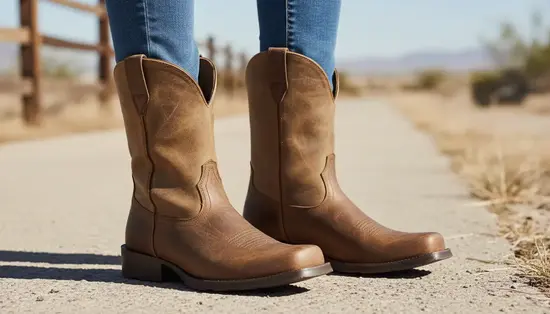
Men’s leather cowboy boots traditionally emphasize function and understated style. Classic brown and black options dominate, though adventurous dressers increasingly embrace unique finishes and textures.
Work boots prioritize durability and protection, while dress boots focus on refined leather and elegant detailing. Understanding your primary use case helps narrow options in this expansive category.
Contemporary men’s cowboy boots balance heritage and innovation. Traditional construction methods meet modern comfort technologies, creating footwear that honors Western traditions while addressing current lifestyle demands.
Whether you need boots for ranch work, professional settings, or weekend adventures, men’s leather cowboy boots deliver uncompromising quality.
Color Selection Strategy for Leather Cowboy Boots
Black Leather Cowboy Boots
Black leather cowboy boots project sophistication and formality. They transition seamlessly from casual daytime wear to evening events, making them exceptionally versatile wardrobe investments.
Black leather requires less visible maintenance than lighter colors, though proper care remains essential for longevity.
The enduring popularity of black cowboy boots stems from their ability to anchor virtually any outfit. They provide striking contrast against light-colored clothing while creating cohesive looks with darker ensembles.
For those building their first quality boot collection, black represents the most practical starting point.
Brown Leather Cowboy Boots
Brown leather cowboy boots in various shades offer maximum versatility. Light tan suits summer styling and casual aesthetics. Medium brown works year-round with virtually any color palette.
Deep chocolate brown approaches black’s formality while maintaining warmth. Brown leather develops particularly attractive patina, with wear patterns creating rich depth that enhances rather than detracts from appearance.
The natural variations in brown leather create unique character in each pair. From cognac to chestnut to mahogany, brown cowboy boots complement denim perfectly while elevating casual and business casual outfits with equal effectiveness.
Specialty Colors and Unique Finishes
Specialty colors allow personal expression through footwear. Red leather cowboy boots make bold fashion statements while maintaining Western authenticity.
Vintage colors feature deliberate aging effects that suggest decades of character development. These options work best when you’re comfortable letting your boots claim attention as outfit focal points.
Vintage Leather Cowboy Boots: Authentication and Value
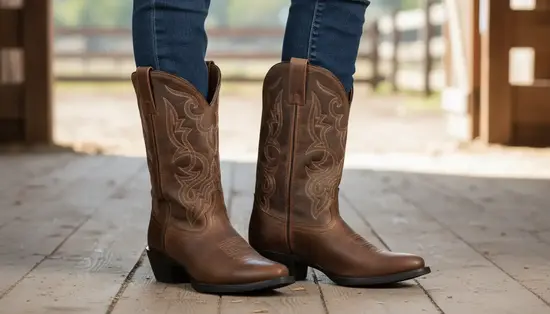
Genuine vintage leather cowboy boots represent wearable history, but authentication requires knowledge. Examine interior stamps and labels for brand names, size markings, and manufacturing locations.
Research when specific companies operated from particular facilities to verify claimed ages. Justin’s Diamond J line, for example, has distinct characteristics across different production eras.
Leather condition tells significant stories. Vintage leather should show age-appropriate wear—natural creasing, subtle color variation, and grain texture changes.
Be suspicious of “vintage” boots with pristine, uniform appearance. Quality vintage leather remains supple despite age, while poor storage results in cracking and stiffness that no amount of conditioning can reverse.
Original hardware provides authentication clues. Vintage cowboy boots feature specific zipper brands, buckle styles, and nail types corresponding to their manufacturing periods. Replacement components aren’t dealbreakers but should influence pricing.
Examine stitching quality and thread type—hand-stitched details indicate higher-end construction that validates premium pricing.
Collectors particularly value vintage roper boots from established makers like Justin. The vintage Justin Diamond J red leather roper cowboy boots represent this category’s appeal—combining authentic working cowboy heritage with distinctive styling that stands out in modern contexts.
Achieving Proper Fit in Cowboy Boots
Cowboy boot sizing differs fundamentally from athletic shoe measurements. Boots should fit snugly through the instep and heel while allowing toe room. Your heel should lift slightly when walking but never slip excessively.
Many buyers size down half to full size from their sneaker measurement, though this varies by brand and foot shape.
Width considerations matter enormously in cowboy boots. Standard width works for average feet, but wide or narrow options accommodate different foot shapes.
The instep—where boot opening meets foot top—creates fit challenges for high-arched feet. Try boots on with appropriate socks, and walk extensively in-store before committing to online purchases.
The Break-In Period
Expect a break-in period with new leather cowboy boots. Quality leather initially feels stiff but gradually conforms to your foot’s unique contours.
This process typically requires two to four weeks of regular wear. Accelerate breaking-in by wearing boots for progressively longer periods, treating leather with conditioner to enhance pliability, and using boot stretchers on particularly tight areas.
Don’t panic if new boots feel uncomfortable initially. Leather stretches and molds, transforming rigid footwear into custom-fit comfort.
However, distinguish between normal break-in discomfort and genuinely poor fit. Boots causing severe pain or numbness require different sizing, not just patience.
Construction Quality Indicators
Leather Sole Cowboy Boots
Leather sole cowboy boots represent traditional construction at its finest. These soles mold to your gait over time, providing customized comfort. However, leather soles lack traction on wet surfaces and wear more quickly than rubber alternatives.
They suit dress occasions and dry environments while requiring periodic resoling to maintain functionality.
The elegance of leather soles appeals to purists who value authentic Western construction. These soles breathe better than rubber, reducing foot moisture and odor.
For collectors and those prioritizing traditional aesthetics, leather soles remain the gold standard despite practical limitations.
Rubber vs. Leather Soles
Rubber soles deliver practical advantages for active wear. Superior traction, weather resistance, and longevity make them ideal for work boots and everyday use.
Modern rubber compounds provide cushioning that leather cannot match, though purists argue this sacrifices authentic Western aesthetics. Many quality boots offer hybrid constructions incorporating both materials’ benefits.
Stitching and Craftsmanship Details
Goodyear welt construction indicates serious quality commitment. This method attaches uppers to soles using stitched welts rather than adhesives, creating water-resistant seams and allowing multiple resole cycles.
Boots with Goodyear welts cost more initially but deliver superior value across their extended lifespans.
Hand-stitched decorative elements suggest craftsmanship attention that typically extends throughout construction.
Examine stitch consistency, thread quality, and pattern precision. Machine stitching works perfectly for structural components, but hand-stitched details demonstrate artisan involvement that elevates boots from functional footwear to wearable art.
Buying Guide: Choosing Your Perfect Leather Cowboy Boots
Identify Your Purpose
Before purchasing leather cowboy boots, clarify your primary use case. Work environments demand different features than fashion applications.
Riding requires specific heel angles and toe shapes. Everyday wear prioritizes comfort and versatility over specialized function.
Budget-conscious buyers should invest in one excellent pair rather than multiple mediocre options.
Quality leather cowboy boots properly maintained outlast cheaper alternatives by decades, making them more economical long-term despite higher initial costs.
Key Factors to Consider
Leather quality tops the priority list. Examine grain patterns, flexibility, and thickness. Quality leather feels substantial without excessive stiffness.
Check for consistent color and texture across both boots—significant variations suggest lower-grade materials.
Toe shape affects both aesthetics and comfort. Pointed toes create traditional Western profiles but may cramp feet with wider toe boxes.
Rounded toes offer more room but appear less formal. Square toes split the difference, providing space while maintaining distinctive Western character.
Heel type determines stability and purpose suitability. Higher, angled heels suit riding and traditional styling.
Lower, squared heels work better for walking and work applications. Consider where and how you’ll wear boots most frequently when selecting heel configurations.
Price Ranges and Value
Budget leather cowboy boots start around $150-$250, offering decent quality for occasional wear. Mid-range options ($250-$500) provide excellent materials and construction for regular use. Premium boots ($500-$1,500+) feature exotic leathers, superior craftsmanship, and often handmade construction.
Vintage leather cowboy boots vary dramatically in price based on rarity, condition, and brand prestige. Research comparable sales before purchasing vintage pieces. Condition matters more than age—a well-maintained 20-year-old boot outperforms a neglected 50-year-old treasure.
Essential Care for Leather Cowboy Boots
Why Leather Care Matters
Leather conditioner represents your most important maintenance tool. This product replenishes natural oils that evaporate during wear, preventing leather from becoming brittle and cracked.
Apply conditioner every three to six months depending on wear frequency and environmental conditions. Exotic leathers often require specialized conditioning formulas—verify compatibility before application.
Proper care extends boot lifespan from years to decades. Well-maintained leather cowboy boots become family heirlooms, developing character that tells stories of adventures shared and miles traveled.
Neglected boots deteriorate rapidly, losing flexibility and developing permanent damage that compromises both appearance and structural integrity.
Using Leather Conditioner for Cowboy Boots
Select leather conditioner for cowboy boots specifically formulated for your leather type. Standard cowhide accepts most quality conditioners, but exotic leathers require specialized products.
Apply conditioner to clean, dry boots using soft cloths or applicator brushes. Work product into leather using circular motions, paying special attention to flex points where leather bends during wear.
Allow conditioner to absorb fully before buffing away excess. Over-conditioning creates greasy buildup that attracts dirt and dulls appearance.
Properly conditioned leather feels supple and looks slightly enriched without appearing wet or shiny. Frequency depends on wear patterns—daily use demands more frequent conditioning than occasional wear.
Cleaning and Polishing Routine
Regular cleaning prevents dirt accumulation that degrades leather over time. Remove surface dust with soft brushes before it works into grain patterns.
For deeper cleaning, use leather-specific cleaners rather than household products containing harsh chemicals. Spot-treat stains immediately, as aged stains become increasingly difficult to remove without professional intervention.
Polish smooth leather cowboy boots after cleaning to restore shine and add protective layers. Choose polish colors matching your leather or go slightly darker—never lighter.
Apply thin coats, allowing each to dry before adding more. Buff thoroughly with soft cloths for mirror-like finishes on dress boots.
Waterproofing treatments provide additional protection though they slightly alter leather appearance and breathability. Apply these products to work boots or any footwear regularly exposed to moisture.
Reapplication becomes necessary as treatments wear away through use. Remember that waterproofing doesn’t make boots invincible—prolonged water exposure still causes damage requiring professional restoration.
Storage and Longevity Tips
Boot Trees and Shape Maintenance
Boot trees maintain shape during storage periods, preventing the leather from developing permanent creases that compromise structure and appearance.
Cedar boot trees additionally absorb moisture and odors while naturally repelling insects. These simple tools dramatically extend boot longevity by preventing shape distortion that occurs when boots collapse during storage.
Insert boot trees immediately after removing boots while leather retains warmth and flexibility. This timing maximizes shaping effectiveness.
For tall-shaft boots, trees supporting the entire leg portion prevent unsightly shaft creasing that mars appearance even when boots are worn.
Proper Storage Environment
Store leather cowboy boots in climate-controlled environments avoiding extreme temperature fluctuations and humidity levels.
Excessive heat dries leather out rapidly, while high humidity promotes mold growth and material degradation. Keep boots away from direct sunlight, which fades colors and weakens leather fibers.
Dust boots before storage and stuff shafts with acid-free paper if boot trees aren’t available.
Never store leather cowboy boots in plastic bags or containers that trap moisture. Breathable fabric bags protect against dust while allowing air circulation that prevents mildew.
Preventing Leather Cracking
Leather cracking results from dehydration—natural oils evaporate faster than they’re replenished.
Combat this through regular conditioning, proper storage, and avoiding prolonged exposure to heat sources. Cracked leather loses structural integrity and rarely accepts repairs successfully.
Inspect boots regularly for early cracking signs: lightened color, stiffness, or fine surface lines. Address these immediately with intensive conditioning treatments.
Severely cracked leather requires professional restoration or replacement—prevention through consistent care remains far more effective than remediation.
Matching Leather Cowboy Boots With Outfits
Casual Styling Options
Leather cowboy boots have transcended their Western origins to become fashion staples across style categories.
Casual looks benefit from boots’ inherent texture and visual interest. Pair them with straight-leg or skinny jeans allowing boot details to show.
Flowing dresses and skirts create appealing contrasts between feminine silhouettes and boots’ structured forms.
Weekend styling embraces cowboy boots’ versatility. Layer them with denim jackets, flannel shirts, and relaxed tees for effortless cool.
During warmer months, pair boots with shorts and tank tops for unexpected combinations that showcase personal style confidence.
Business Casual Applications
Business casual environments increasingly accept quality leather cowboy boots as appropriate footwear. Choose clean-lined boots in black or brown without excessive decorative elements.
Pair with tailored trousers or knee-length skirts, ensuring boot shafts remain visible. Leather condition becomes crucial in professional settings—maintain impeccable shine and address any visible damage promptly.
Women can style cowboy boots with blazers, button-down shirts, and structured accessories for polished professional looks.
Men should coordinate boot colors with belt leather and keep overall styling understated, letting quality footwear speak for itself without overwhelming business contexts.
Western and Rodeo Styling
Authentic Western styling showcases cowboy boots in their native context. Pair boots with Western shirts featuring pearl snaps, tailored denim jeans, and leather belts with substantial buckles.
Add cowboy hats and accessories honoring Western heritage without veering into costume territory.
Rodeo events and Western-themed occasions provide opportunities to embrace more elaborate boot designs.
Intricate stitching, exotic leathers, and bold colors find appropriate contexts at these gatherings where fashion expectations celebrate Western tradition.
Seasonal Considerations for Leather Cowboy Boots
Summer Wear Strategies
Summer wear demands breathable leather and lighter colors reflecting rather than absorbing heat. Shorter shaft heights improve air circulation around legs.
Pair summer boots with lightweight fabrics and relaxed silhouettes appropriate for warm weather. Exotic leathers like ostrich provide superior breathability compared to standard cowhide options.
Light-colored leather cowboy boots suit summer aesthetics but require more visible maintenance.
Tan, beige, and natural leather tones complement warm-weather wardrobes while staying cooler than dark colors. Apply protective treatments before wearing light boots to minimize staining from grass, dirt, and moisture.
Winter Protection and Styling
Winter conditions require waterproofing treatments and potentially insulated linings. Darker leather colors hide salt stains and weather damage better than light shades.
Apply protective treatments before winter’s first snowfall rather than after damage occurs. Consider keeping boots specifically designated for harsh weather separate from your prized dress boots.
Insulated leather cowboy boots provide warmth without bulk. Look for Thinsulate or similar modern insulation technologies that offer thermal protection without compromising fit.
Pair winter boots with heavy denim, wool trousers, and weather-appropriate outerwear for both style and practicality.
Top Brands for Quality Leather Cowboy Boots
Heritage Makers
Justin Boots pioneered cowboy boot manufacturing, establishing quality standards that competitors still chase.
Their Diamond J line represents vintage excellence, while contemporary offerings balance tradition with innovation. Justin’s widespread availability and consistent sizing make them reliable choices for first-time buyers.
Lucchese creates handcrafted luxury cowboy boots commanding premium prices. Their exotic leather selections and meticulous construction appeal to serious collectors and those seeking ultimate quality.
Lucchese boots require significant investment but deliver unmatched craftsmanship and prestige.
Tony Lama offers excellent value in mid-range pricing tiers. Their boots feature quality leather and solid construction without luxury brand markups.
Tony Lama represents smart choices for buyers wanting authentic Western boots without maximum expenditure.
Contemporary Brands
Ariat revolutionized cowboy boots by incorporating athletic footwear technologies. Their boots provide superior comfort for all-day wear while maintaining Western aesthetics.
Ariat particularly excels in work boot categories where comfort and durability matter most.
Tecovas disrupted traditional retail models through direct-to-consumer sales. Their boots offer impressive quality at competitive prices by eliminating middlemen.
Tecovas appeals to modern buyers comfortable with online purchasing who value transparency and value.
Common Problems and Solutions
Squeaking Leather Boots
Squeaking leather cowboy boots typically result from friction between sole layers or between upper leather and lining.
Apply leather conditioner to all surfaces, including interiors. Powdered baby powder or talcum between insoles and footbeds often eliminates squeaking by reducing friction.
If squeaking persists, identify the specific source. Flex boots while listening carefully to pinpoint problem areas.
Sometimes resoling or professional repairs address structural issues causing persistent squeaking that home remedies cannot fix.
Repairing Scuffs and Scratches
Minor scuffs on leather cowboy boots disappear with proper conditioning and polishing. Deep scratches require leather repair compounds matching boot colors.
Apply compounds carefully, building thin layers until scratches fill completely. Buff thoroughly after compounds dry to blend repairs with surrounding leather.
For valuable vintage leather cowboy boots, consider professional restoration for significant damage.
Expert craftspeople possess specialized tools and materials that achieve superior results compared to home repairs. Prevention through careful wear and proper storage remains more effective than remediation.
Emergency Treatment for Dried Leather
Severely dried leather requires intensive treatment. Apply generous conditioner coats, allowing each to absorb fully before adding more.
Repeat daily until leather regains flexibility. This process may require weeks for severely neglected boots.
Leather dried to cracking points rarely fully recovers. Prevention through consistent conditioning every three to six months avoids emergency situations requiring heroic rescue efforts. Consider dried leather a cautionary tale motivating proper maintenance habits.
Sustainability and Ethical Considerations
Modern consumers increasingly consider environmental and ethical factors when purchasing leather cowboy boots.
Eco-friendly tanning processes minimize chemical usage and water pollution. Seek brands transparently disclosing their tanning methods and environmental commitments.
Vegan leather alternatives exist for those avoiding animal products. However, synthetic materials lack genuine leather’s durability and aging characteristics.
Weigh personal values against practical considerations when choosing between leather and alternatives.
Responsible brands source leather from facilities maintaining humane animal treatment standards and fair labor practices.
Research brand reputations before purchasing. Supporting ethical makers encourages industry-wide improvements while ensuring your boots reflect your values.
Where to Buy Leather Cowboy Boots
Online Shopping Strategies
Online stores offer vast selections and competitive pricing. However, buying cowboy boots without trying them on carries risks. Order multiple sizes, expecting to return some. Read return policies carefully before purchasing. V
erify authenticity through authorized dealer confirmations, especially when buying premium brands or vintage pieces.
Marketplace platforms like eBay and Poshmark provide access to vintage and discontinued styles. Exercise caution with authentication.
Request detailed photos, ask specific questions about condition, and research sellers’ reputations. Understand that marketplace purchases often lack return protections standard retailers provide.
In-Store Shopping Advantages
Physical stores allow trying boots before committing. Expert staff can assess fit and recommend appropriate sizes based on your feet’s unique characteristics.
Inspect leather quality firsthand, checking for consistency and manufacturing defects. In-store shopping particularly benefits first-time buyers unfamiliar with cowboy boot sizing conventions.
Specialty Western wear stores offer superior selections compared to general shoe retailers. Staff knowledge and brand varieties justify visits to dedicated Western stores even when they’re not closest or cheapest options.
Current Trends in Leather Cowboy Boots
Women’s leather cowboy boots have experienced surging demand over the past month, with black and brown options leading sales.
This trend reflects boots’ ongoing transition from Western specialty to mainstream fashion essential. Social media influencers and celebrities wearing cowboy boots in unexpected contexts drive continued interest and sales growth.
Vintage and roper style leather cowboy boots are enjoying renewed popularity. Consumers appreciate these styles’ authenticity and connection to working cowboy heritage.
The vintage Justin Diamond J roper boots exemplify this trend—collectors and fashion-forward buyers equally prize these distinctive pieces.
Color trends favor classic black and brown, though adventurous buyers increasingly embrace unique shades and finishes.
Bold colors make statements while earth tones provide versatility. The market accommodates both conservative and experimental preferences, ensuring options for every style sensibility.
Key Takeaways for Leather Cowboy Boot Success
Quality leather cowboy boots represent significant investments rewarding proper selection and maintenance with decades of reliable service.
Prioritize leather quality, construction methods, and proper fit over trendy designs or bargain pricing. Understand that excellent boots cost more initially but deliver superior value through extended lifespans.
Commit to regular care routines including cleaning, conditioning, and proper storage. These simple practices protect your investment while ensuring boots remain beautiful and functional throughout years of wear.
Leather conditioner for cowboy boots isn’t optional luxury—it’s essential maintenance preventing deterioration.
Whether you choose classic black cowboy boots, versatile brown leather options, or distinctive vintage styles, your leather cowboy boots will develop unique character that synthetic alternatives simply cannot replicate.
Each wear adds to your boots’ story, creating patina and personality that makes them increasingly valuable both practically and sentimentally.
Select boots aligning with your lifestyle needs. Work requires durability and protection. Fashion prioritizes aesthetics and styling versatility.
Riding demands specific functional features. Understanding your primary use case ensures satisfaction with your purchase.
Finally, embrace the break-in period and allow quality leather to conform to your feet. The temporary discomfort yields long-term comfort that makes properly fitted leather cowboy boots some of the most comfortable footwear you’ll ever own.
Frequently Asked Questions
Are leather cowboy boots waterproof?
Leather cowboy boots are not naturally waterproof, though they provide some water resistance.
Applying waterproofing treatments enhances protection but doesn’t make boots invincible. Avoid prolonged water exposure even with treatments. Dry wet boots slowly at room temperature, never near direct heat sources.
How often should I apply leather conditioner?
Apply leather conditioner for cowboy boots every three to six months with regular wear. Boots worn daily in harsh conditions need more frequent conditioning.
Occasionally worn boots may extend intervals slightly. Always condition after exposure to rain or snow.
What is the difference between roper boots and traditional cowboy boots?
Roper boots feature rounded toes and lower, squared heels compared to traditional cowboy boots’ pointed toes and angled heels.
Roper boots prioritize walking comfort, while traditional styles emphasize riding functionality and formal appearance. Both represent authentic Western styles suited to different purposes.
Which leather type lasts the longest?
Full-grain leather lasts longest due to its complete fiber structure and natural durability. Properly maintained full-grain leather cowboy boots can last 20-30+ years.
Exotic leathers vary in durability—ostrich and alligator are extremely durable while some snake leathers are more delicate.
How do I know if my leather cowboy boots fit correctly?
Properly fitted leather cowboy boots feel snug through the instep and heel with slight heel lift when walking.
Toes should have wiggle room without sliding forward. The ball of your foot should align with the boot’s widest point. Expect initial stiffness that improves during break-in.
Are leather soles better than rubber soles?
Leather soles offer traditional aesthetics and breathability but lack rubber soles’ traction and durability. Rubber soles work better for work applications and wet conditions.
Leather soles suit dress occasions and dry environments. Neither is universally “better”—select based on your primary use case.
Can women style cowboy boots with business outfits?
Yes, women can successfully style quality leather cowboy boots with business casual outfits. Choose clean-lined boots in classic colors without excessive decoration.
Pair with tailored trousers, blazers, and professional accessories. Maintain boots in excellent condition for workplace appropriateness.
What are the best brands for budget leather cowboy boots?
Ariat, Justin, and Tony Lama offer excellent entry-level leather cowboy boots balancing quality with affordability.
Tecovas provides competitive pricing through direct sales. Budget $200-$350 for decent quality boots suitable for regular wear. Avoid boots under $150—they typically lack quality leather and construction necessary for longevity.


